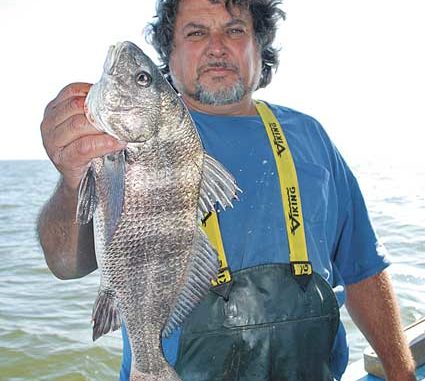
The black drum is the North American heavyweight of the large and diverse drum family, which includes speckled trout, redfish, croakers and kingfish (more often called channel mullet or whiting). The Louisiana record of 79.5 pounds, set in 2007 by Dylan Gonzales, falls far short of the 113-pound world record fish caught in Delaware in 1975. Besides growing to large sizes, it is also an extremely common inshore saltwater fish.
In spite of its pedigree, numbers and accessibility, the black drum is not a popular fish with recreational anglers. Recreational fishing surveys indicate that speckled trout and redfish are the primary target species for 90 percent of saltwater anglers in Louisiana. Flounder come in third and finally, in fourth place, is the black drum.
The low interest in black drum may largely be due to its disdain for striking artificial baits, an important requirement to meet the original definition of a game fish. And it may partly be due to the high incidence of parasitic worms in the flesh of some older specimens.
Carrying a large head and muscular “shoulders,” the black drum resembles nothing so much as a swimming bull bison. When hooked, the fight is a slug fest, with none of the sizzling runs of redfish nor energy-wasting acrobatics of speckled trout.
In spite of its awkward body shape, the black drum can be an attractive fish. Fish under 2 pounds have a background body color of quicksilver overlaid by chromatic vertical black bars. Unfortunately, the spectacularly contrasting body color fades as the fish get older and larger, until they appear to have an overall blackish or gray color.
In Louisiana, black drum spawning commonly takes place in coastal passes, very much the same areas that speckled trout and redfish cast their seed into the sea. They just do it at a different time of the year. The peak spawning period for redfish is August and September, and prime time for specks is May through August.
Black drum spawning occurs from November to May, but the peak of activity is in February and March, which is soon coming up. Females will spawn 20 to 30 times per season, producing 11-60 million eggs. Spawning generally occurs between 7 and 10 p.m.
In spite of the huge number of eggs produced, some spawns in some years are much more successful in producing fish than other years. It appears that these strong year-classes occur every 4 to 5 years.
LSU fisheries scientists have located numerous black drum spawning aggregations by using hydrophones to zero in on the drumming sounds made by ready-to-spawn schools of males. These spawning aggregations were frequently located in deep-moving water between barrier islands (like Grand Isle or Grand Terre) as well as in channels in open water, in depths between 10 and 165 feet.
The locations changed with seasons and environmental conditions. Water temperatures at spawning temperatures ranged from 59 to 75 degrees. Black drum spawning sites were closely tied to the amount of dissolved oxygen in the water, with the more oxygen the better.
Scientists have compared the amount of eggs produced to the body weight of female black drum, redfish and speckled trout. For redfish, the number of eggs produced per pound of body weight increases as the fish gets larger. Black drum appear to be similar to speckled trout in that the number of eggs produced per pound of body weight decreases as the fish get older and larger.
After being spawned, the eggs are carried seaward by currents until they hatch. Larval (baby) and small black drum then tend to travel inland with incoming tides where they settle out in the marshes to grow.
At 24 to 26 inches and 4 to 5 years of age, they become sexually mature and begin to spawn. Mature black drum form large schools before the beginning of spawning season. Often 20,000-60,000 pounds of fish will be in one of these offshore schools, frequently mixed with cownose rays and occasionally with crevalle jacks and redfish. After spawning season, these schools seem to break up.
Black drum are long-lived fish, with most studies indicating a maximum age of over 40 years and one study in Florida estimating a maximum age of 58 years. Growth is very rapid until they reach about 20 inches; then it tapers off. The accompanying table gives growth rate information for the species.
During the winter months, when fishermen often sweeten their jig heads with a bit of market shrimp, black drum will readily take the hook. Wise anglers don’t disdain these “bonus fish.” Black drum under 10 pounds are excellent table fare.
Jerald Horst is an author of the Angler’s Guide to Fishes of the Gulf of Mexico, a 444-page, color-illustrated book on fishes written for saltwater fishermen. The book is available in better bookstores or can be ordered by calling 800-843-1724.


